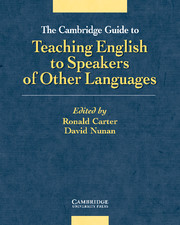Book contents
- Frontmatter
- Contents
- List of figures
- List of abbreviations
- Acknowledgements
- List of contributors
- Introduction
- Chapter 1 Listening
- Chapter 2 Speaking
- Chapter 3 Reading
- Chapter 4 Writing
- Chapter 5 Grammar
- Chapter 6 Vocabulary
- Chapter 7 Discourse
- Chapter 8 Pronunciation
- Chapter 9 Materials development
- Chapter 10 Second language teacher education
- Chapter 11 Psycholinguistics
- Chapter 12 Second language acquisition
- Chapter 13 Bilingualism
- Chapter 14 Sociolinguistics
- Chapter 15 Computer-assisted language learning
- Chapter 16 Observation
- Chapter 17 Classroom interaction
- Chapter 18 English for academic purposes
- Chapter 19 English for specific purposes
- Chapter 20 Assessment
- Chapter 21 Evaluation
- Chapter 22 Syllabus design
- Chapter 23 Language awareness
- Chapter 24 Language learning strategies
- Chapter 25 Task-based language learning
- Chapter 26 Literature in the language classroom
- Chapter 27 Genre
- Chapter 28 Programme management
- Chapter 29 Intercultural communication
- Chapter 30 On-line communication
- Postscript: The ideology of TESOL
- Glossary
- References
- Index
Chapter 19 - English for specific purposes
Published online by Cambridge University Press: 07 September 2010
- Frontmatter
- Contents
- List of figures
- List of abbreviations
- Acknowledgements
- List of contributors
- Introduction
- Chapter 1 Listening
- Chapter 2 Speaking
- Chapter 3 Reading
- Chapter 4 Writing
- Chapter 5 Grammar
- Chapter 6 Vocabulary
- Chapter 7 Discourse
- Chapter 8 Pronunciation
- Chapter 9 Materials development
- Chapter 10 Second language teacher education
- Chapter 11 Psycholinguistics
- Chapter 12 Second language acquisition
- Chapter 13 Bilingualism
- Chapter 14 Sociolinguistics
- Chapter 15 Computer-assisted language learning
- Chapter 16 Observation
- Chapter 17 Classroom interaction
- Chapter 18 English for academic purposes
- Chapter 19 English for specific purposes
- Chapter 20 Assessment
- Chapter 21 Evaluation
- Chapter 22 Syllabus design
- Chapter 23 Language awareness
- Chapter 24 Language learning strategies
- Chapter 25 Task-based language learning
- Chapter 26 Literature in the language classroom
- Chapter 27 Genre
- Chapter 28 Programme management
- Chapter 29 Intercultural communication
- Chapter 30 On-line communication
- Postscript: The ideology of TESOL
- Glossary
- References
- Index
Summary
Introduction
English for specific purposes (ESP) has for about 30 years been a separate branch of English Language Teaching. It has developed its own approaches, materials and methodology and is generally seen as a very active, even ‘feisty’ movement that has had considerable influence over the more general activities of TESOL and applied linguistics.
ESP has always seen itself as materials-driven and as a classroom-based activity concerned with practical outcomes. Most writing about ESP is concerned with aspects of teaching, materials production and text analysis rather than with the development of a theory of ESP.
Background
DEFINITION OF ESP
The key defining feature of ESP is that its teaching and materials are founded on the results of needs analysis. The first questions when starting preparation for teaching an ESP course is almost always: What do students need to do with English? Which of the skills do they need to master and how well? Which genres do they need to master, either for comprehension or production purposes? Various commentators (notably Brumfit 1984a) have remarked that needs analysis is not exclusive to ESP and that much general TESOL – especially when following the communicative approach – is based on needs analysis. However, in ESP one can be more precise about learners' needs; their needs are defined by a learning or occupational situation in which English plays a key role (see Chapter 18).
- Type
- Chapter
- Information
- Publisher: Cambridge University PressPrint publication year: 2001
- 20
- Cited by



